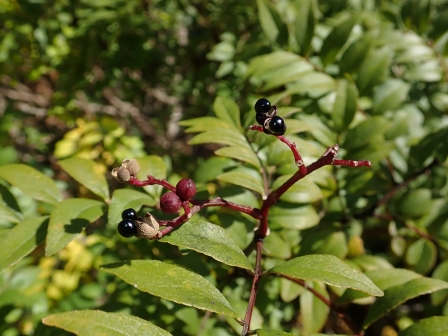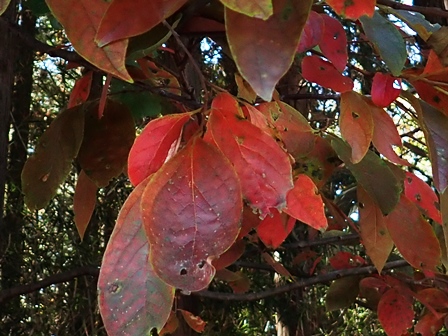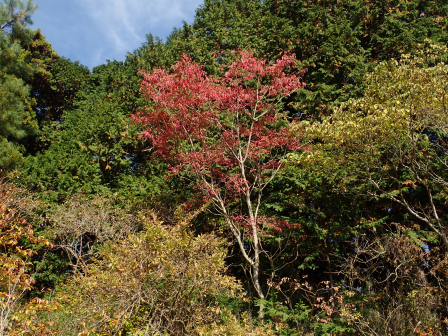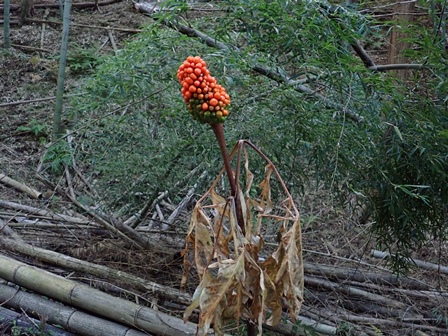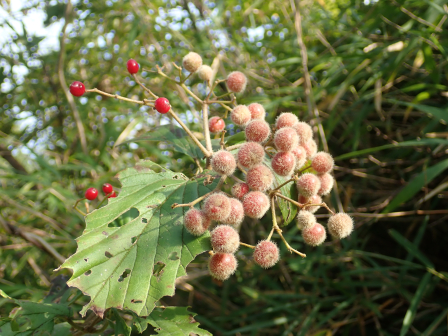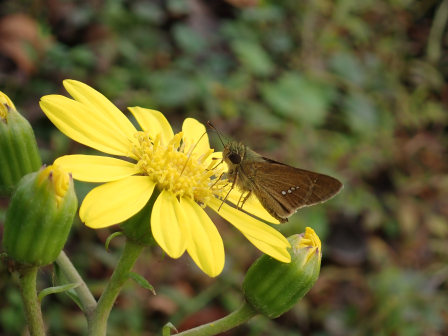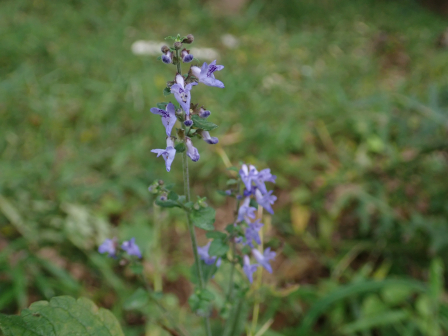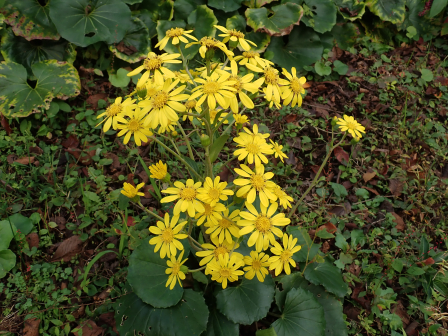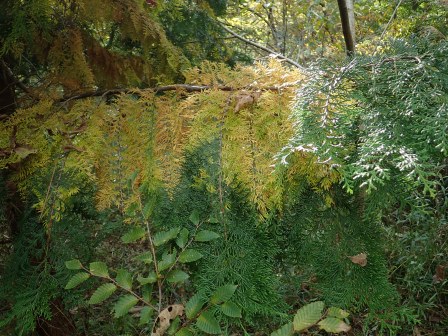フィールド日記
2022年11月
2022.11.29
イヌザンショウ
第1オークヒルでイヌザンショウの木が見られます。香辛料として使われるサンショウに似ていて、あまり香りがよくないことからイヌザンショウと呼ばれているようです。果実は赤く熟したあと裂開し、写真のように黒い光沢のある種子が出てきます。
There are "Inu-Zanshou" trees in the First Oak Hill. They resemble "Sanshou (サンショウ)" trees that are used as a spice, but they don't smell as good as "Sanshou" trees, so they are called "Inu-Zanshou". When their fruits ripen, they open and the shiny black seeds come out from them as you can see in the photo.
2022.11.25
カキノキ
第2オークヒルのカキノキ(柿の木)が鮮やかな赤色に紅葉していました。カキノキは広く栽培されていますが、まれに林内に逸出したものが見られます。この木もおそらく動物によって運ばれた種から自然に生えてきたものと思われ、果実は小さく食用にはならなそうですが、葉は美しく紅葉していました。
The leaves of the persimmon tree in the Second Oak Hill are turning bright red. Persimmon trees are widely cultivated and occasionally escape into forests and grow there. This tree in the photo has probably grown from a seed that a wild animal dropped. The fruit of the tree is too small to eat, but the leaves have turned the beautiful autumn colors.
2022.11.22
リュウキュウハゼ
キャンパス内で様々な樹木の紅葉が見られます。第一オークヒルには数本のリュウキュウハゼ(ハゼノキ)があり、鮮やかな赤い葉がひときわ目を引きます。
We are enjoying autumn colors of various trees on our campus. There are several "Ryukyu-Haze (リュウキュウハゼ)" (or "Hazenoki (ハゼノキ)") trees in the first Oak Hill, and their bright red leaves are very beautiful.
2022.11.18
スルガテンナンショウ
竹林でテンナンショウの仲間の果実を見つけました。キャンパス内で見られるテンナンショウの仲間のほとんどがスルガテンナンショウなので、これはスルガテンナンショウの果実だと思われます。赤いトウモロコシのような形をしていますが、毒があるため食べることはできません。
I found a fruit of a plant belonging to the "Tennanshou (テンナンショウ)" group. This fruit should be "Suruga-Tennanshou (スルガテンナンショウ)" because almost all plants belonging to the "Tennannshou" group that we can find on our campus are "Suruga-Tennanshou". The fruit looks like a red corn but it is poisonous and inedible.
2022.11.15
ガマズミミケフシ
ススキ野原の入り口でガマズミミケフシが見られます。ガマズミミケフシとは、タマバエの一種がガマズミの実に寄生することで生じる虫こぶのことです。写真の左の赤い果実が正常なガマズミの果実ですが、タマバエが卵を産むことで組織が変化し、丸く毛におおわれた虫こぶになります。
I found "Gamazumi-Mikefushi (ガマズミミケフシ)" at the entrance of the Japanese pampas grass field. "Gamazumi-Mikefusi" is a gall produced by a gall midge that is parasitizing in the fruit of "Gamazumi (ガマズミ)" trees. The normal "Gamazumi" fruit is red as you can see on the left side of the photo. However, after a gall midge lays its eggs on the fruit, the tissue changes and the fruit turns round and hairy.
2022.11.11
イチモンジセセリ
イチモンジセセリがツワブキの花を訪れていました。名前の通り、翅の4つの白い斑紋が一列に並びます。個体数も多い普通種で、花を訪れている姿をよく見ます。
I found a "Ichimonji-Seseri (イチモンジセセリ)" butterfly visiting a "Tsuwabuki (ツワブキ)" flower. As the name suggests, four white spots on its wings are in line. They are a common species with large population, so you can often see them visiting flowers.
2022.11.08
ヤマハッカ
クヌギ林でヤマハッカが咲いていました。和名は山に咲くハッカという意味だと思われますがハッカのような匂いはありません。よく似た種にイヌヤマハッカがありますが、ヤマハッカの花びらには紫の点があることで区別することができます。
"Yamahakka" plants are in bloom in the Japanese chestnut oak woodland. The name means that they are plants looking like "Hakka (ハッカ)" that grow in mountains, but they don't smell like "Hakka" plants. There is a close relative plant called "Inu-Yamahakka," but you can tell "Yamahakka" from "Inu-Yamahakka" by checking purple spots on the petals of "Yamahakka" plants.
2022.11.04
ツワブキ
校舎の周りでツワブキが咲いています。キク科に典型的な頭状花で、中心の両性の筒状花とその周りの雌性の舌状花からなります。本来は海岸近くに自生しているようですが、古くから栽培されており、庭など身近なところでよく見られます。
"Tsuwabuki (ツワブキ)" plants are in bloom around the school building. They have a typical flower head of the asteraceae family ,which consist of bisexual tubular flowers in the center surrounded with female ligulate flowers. "Tsuwabuki (ツワブキ)" flowers originally grow near coasts, but they have been cultivated for a long time, so you can see them in familiar places like yards and gardens.
2022.11.01
ヒノキ
キャンパス内のヒノキが黄葉しています。ヒノキは常緑樹で、葉の寿命が1年以上あるため、一斉に黄葉して葉を落とすことはありません。しかし、秋になると枝の根元に近い一部の葉は黄葉し、葉を落としているようです。
The leaves of Japanese cypress trees on the campus are turning yellow. Japanese cypress trees are an evergreen tree and the lifespan of their leaves is more than a year, so their leaves don't turn yellow and drop all at one time. However, some leaves near to the bottom of their branches turn yellow and drop in fall.
- 1 / 1


